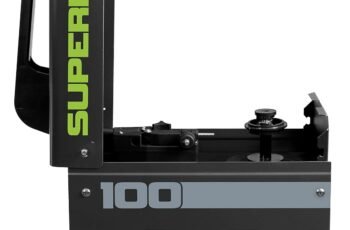Ad Blocker Detected
Our website is made possible by displaying online advertisements to our visitors. Please consider supporting us by disabling your ad blocker.
When deciding between MIG and TIG welding machines for your project, you need to consider several key factors. Each method has its strengths—MIG offers speed and efficiency, while TIG provides precision and control. But which is truly better for your specific needs? It all depends on your project’s scope and materials. Let’s explore how these machines can impact your workflow, costs, and final product quality.
Understanding the Core Technical Differences
When diving into the core technical differences between MIG and TIG welding machines, you’ll quickly notice the distinct roles of electrodes and weld deck handling. MIG welding uses a continuously fed consumable wire serving as both the electrode and filler material. This allows for single-handed operation, simplifying the process significantly. In contrast, TIG welding employs a non-consumable tungsten electrode with a separate handheld filler rod, requiring dual-hand coordination. The tungsten electrode in TIG never melts, offering precise control over the arc, which is ideal for intricate work. MIG welding is faster, making it suitable for projects requiring quick completion times. MIG’s wire acts as both filler and conductor, making material deposition straightforward. Understanding these differences helps you choose the right method based on your project needs and desired precision level.
Material Handling Capacities: Which Metals Suit Each Method?
Recognizing the distinct technical differences between MIG and TIG welding machines sets the stage for understanding their material handling capacities.
With MIG, you can effectively bond carbon steel, stainless steel, aluminum, copper, and nickel. It’s ideal for thicker materials and handles mixed-thickness joints, offering versatility in automotive repairs. MIG also accommodates silicon bronze and other thick-section alloys.
On the other hand, TIG excels with aluminum, stainless steel, titanium, copper, and magnesium, delivering precise welds on thin materials. It’s perfect for nickel alloys, cast iron repairs, and ensures contamination-free joints in electrical components. TIG welding requires advanced hand-eye coordination and precision skills, which allows for the creation of high-quality, intricate designs.
While TIG struggles with zinc and zinc alloys, it achieves seamless fusion on ultra-thin sheets, making it indispensable for specialized, delicate projects.
Precision and Finish Quality in Welding Projects
In welding projects, precision and finish quality are crucial for achieving professional results.
You’ll find that TIG welding excels in these areas. Its tungsten electrode design lets you control the arc focus and intensity with precision, while a foot pedal allows real-time adjustments for perfect bead formation. TIG welding offers better operational control, especially for stainless steel, due to precise heat control and reduced warping.
TIG’s manual filler rod placement ensures clean, spatter-free welds, making it ideal for projects needing polished surfaces, like architectural metalwork. The inert gas shielding in TIG welding also prevents oxidation, leading to defect-free finishes.
In contrast, MIG welding’s automatic wire feed and broader arc can result in larger melt pools and more spatter. This often requires post-weld grinding to achieve a smooth finish, making TIG the better choice for high-quality aesthetics.
Evaluating Production Speed and Workflow Efficiency
While precision and finish quality are paramount in many welding projects, speed and efficiency often take the forefront in high-volume production settings.
If you’re tackling a large-scale project with tight deadlines, MIG welding might be your best bet. It operates 2-5× faster than TIG, crucial for bulk production. For example, MIG can handle a 3mm mild steel plate at 500–600 mm/min, far outpacing TIG’s 100–200 mm/min. The versatility of MIG welding across different metals also adds to its efficiency, making it suitable for a wide range of applications in automotive and construction industries.
The continuous wire feeding in MIG reduces downtime and keeps the workflow smooth, unlike TIG’s manual filler rod that causes interruptions. Plus, MIG’s automatic electrode feeding and broader arc allow for longer, uninterrupted runs.
Its air-cooled torches also prevent overheating during extended use, making it ideal for high-volume tasks.
Comparing Cost and Accessibility Factors
When considering welding equipment, cost and accessibility can significantly impact your decision.
MIG welders are generally more affordable, with prices starting at $200, making them beginner-friendly and widely available. In contrast, TIG welders start at $500 and can exceed $5,000, especially when factoring in additional tools like foot pedals. The simplicity of MIG machines makes them less expensive to purchase compared to the more advanced and costly TIG machines. MIG’s operational costs are lower, too, as it uses cheaper consumables like wire, whereas TIG requires costly inert gases. Additionally, MIG equipment is more readily available, dominating the market and offering competitive prices.
TIG machines, however, are less common and often require specialized components, making them harder to source. If you’re new to welding, MIG’s short learning curve and wider accessibility make it an attractive choice.
Choosing the Right Machine for Automotive and Construction Needs
Why choose between MIG and TIG welding machines for automotive and construction needs?
If you’re working on automotive repairs, MIG is perfect for quickly welding thin panels like steel and aluminum, while TIG offers precision for critical areas needing minimal distortion.
In construction, MIG shines in rapidly assembling large components with its speed and efficiency. However, for joints that require maximum stress resistance, TIG’s quality control and deeper penetration are unmatched.
Consider your material; MIG handles mild steel well, but TIG excels with alloys requiring precise filler matching.
MIG’s automatic wire feed is less labor-intensive, while TIG demands skilled manual control.
Ultimately, the right choice depends on your specific project requirements and the materials you’re working with.
Artistic Fabrication and DIY Project Considerations
Curious about how to choose between MIG and TIG welding for your artistic and DIY projects?
If you’re working with thicker materials like steel, MIG welding is your go-to, offering excellent penetration and speed for sturdy sculptures or furniture frames.
However, for precision in small-scale projects like jewelry or intricate decorative pieces, TIG welding shines with its ability to produce clean, visually appealing welds.
TIG’s control, including the use of a foot pedal, allows for intricate designs and minimal distortion on thin metals like aluminum and copper.
While MIG is more cost-effective and beginner-friendly, TIG requires a higher skill level, offering flexibility with or without filler.
Consider your project’s material, detail needs, and budget to make the right choice.
Navigating Aerospace Industry Requirements With Welding Machines
Navigating the stringent requirements of the aerospace industry with welding machines demands a keen understanding of both the materials and the precision needed for critical components.
TIG welding is your best bet when dealing with complex geometries and exotic alloys, thanks to its superior arc control and minimal imperfections. It excels in meeting AWS D17.1 standards, which prohibit cracks and incomplete fusion, ensuring full-penetration welds that MIG struggles to achieve.
Additionally, TIG’s cleaner welds reduce non-destructive testing costs and align with NASA STD-5006A requirements. While MIG suits non-critical joints, it lacks the precision needed for critical components.
For high-strength structural bonds, especially in lightweight aerospace assemblies, TIG’s precise control and low-distortion performance make it indispensable.
Conclusion
When deciding between MIG and TIG welding machines, think about your project’s specifics. Choose MIG if you need speed and efficiency for thicker materials, especially in large-scale projects. Opt for TIG if precision and high-quality finishes on thinner metals are more important. Consider the material, finish quality, and production speed you need. Ultimately, your project’s requirements will guide your choice, ensuring you pick the right machine for optimal results and satisfaction.



